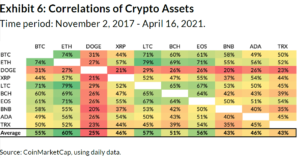The Future of Cryptocurrencies: Fads to Watch in the Coming Years
The development of Central Financial institution Digital Currencies (CBDCs) stands to redefine the assimilation of electronic possessions within standard monetary systems, while raised governing analysis might form the operational landscape for cryptocurrencies. Additionally, the evolution of decentralized finance (DeFi) and the growing importance of non-fungible tokens (NFTs) promise to modify perceptions of ownership and assessment in an electronic economic situation.
Surge of Central Bank Digital Currencies
The emergence of Reserve bank Digital Currencies (CBDCs) represents a significant change in the monetary landscape as governments check out digital alternatives to traditional fiat cash. These state-backed electronic currencies aim to enhance the efficiency of settlement systems, advertise economic inclusion, and provide a secure choice to exclusive cryptocurrencies. Unlike decentralized digital currencies, CBDCs operate under the auspices of reserve banks, making certain regulatory oversight and security.
Numerous nations are proactively piloting or researching CBDCs, with notable instances consisting of China's digital yuan and the European Central Bank's digital euro initiative. These initiatives highlight a growing recognition of the possible benefits of digital money, such as faster deal speeds and lowered expenses connected with cross-border settlements. Moreover, CBDCs might function as a device to fight immoral tasks by providing better transparency in transactions.
As the fostering of CBDCs advances, they might reshape customer habits and impact worldwide economic dynamics. However, the shift to a digital money framework provides challenges, including technical facilities, cybersecurity problems, and public count on. The rise of CBDCs represents a zero hour that can redefine the role of cash in an increasingly digital economic situation, warranting close monitoring by sector stakeholders and policymakers alike.
Enhanced Regulative Analysis

Countries around the world are taking diverse approaches, from outright restrictions to governing sandboxes that allow advancement while making certain compliance. The European Union, for instance, is moving towards detailed regulation with the marketplaces in copyright-Assets Law (MiCA), targeted at developing a unified approach across member states. In the USA, firms like the SEC and CFTC are increasingly active in releasing standards and enforcement activities.
This governing setting is likely to have significant implications for market individuals. Business operating in the copyright room may deal with more stringent conformity needs, which can cause boosted operational prices. Nonetheless, clear laws can additionally foster higher institutional investment, as firms look for to navigate a much more defined legal landscape. Ultimately, the equilibrium in between advancement and guideline will certainly shape the future of click here for info cryptocurrencies.
Advancement of DeFi Operatings Systems
Decentralized Money (DeFi) platforms have undertaken substantial improvement considering that their creation, reshaping the standard economic landscape - order cryptocurrencies. These systems mainly concentrated on easy features such as loaning and loaning, promoted by wise agreements on blockchain networks. Nonetheless, the development of DeFi has actually broadened to encompass a vast range of economic solutions, including by-products trading, yield farming, and automated market-making.
Among the most notable innovations is the appearance of Layer 2 services, which enhance scalability and minimize transaction prices, making DeFi more accessible to a wider target market. Furthermore, cross-chain interoperability has actually become a critical focus, permitting individuals to move assets perfectly throughout different blockchain networks. This development cultivates greater liquidity and user involvement.
Additionally, the assimilation of innovative administration versions has equipped areas to take part in decision-making procedures, promoting sustainability and development within the environment. As DeFi proceeds to mature, we can expect additional enhancements in individual experience with boosted interfaces and safety and security procedures, addressing issues that have formerly prevented mainstream adoption. Overall, the trajectory of DeFi platforms points toward a much more comprehensive and reliable economic future, supplying choices to standard financial systems.
Integration of NFTs in Finance
Among the quick evolution of the monetary landscape, the integration of Non-Fungible Tokens (NFTs) has actually emerged as a transformative force. Typically related to digital art and antiques, NFTs are now locating applications in numerous economic sectors, introducing innovative means to stand for possession and worth.
One substantial area of integration is in real estate, where NFTs can streamline home deals. By tokenizing property possessions, purchasers can enjoy fractional possession, lowering access obstacles and boosting liquidity. order cryptocurrencies. Furthermore, NFTs can make sure transparent and unalterable documents of possession, boosting trust fund in realty negotiations
In the world of finance, NFTs are additionally being made use of for decentralized financing (DeFi) applications, allowing collateralization of assets. By utilizing NFTs as security, debtors can access fundings while keeping ownership of their electronic assets. This capability improves the ease of access of financial solutions and promotes an extra comprehensive financial environment.
Furthermore, the integration of NFTs right into conventional finance can transform the means copyright rights are taken care of, offering creators with brand-new revenue streams via smart contracts. In general, the integration of NFTs look these up in finance symbolizes a change in the direction of even more innovative, efficient, and transparent monetary solutions, paving the method for future advancements.
Innovations in Blockchain Technology

One significant trend is the development of Layer 2 services, created to boost scalability and transaction rates, thereby dealing with the restrictions of primary blockchain networks. These solutions enable faster processing of deals, lowering fees and increasing performance, which is crucial for mass adoption.
Moreover, interoperability between different blockchain networks is acquiring grip. This growth enables seamless data exchange and possession transfers throughout varied systems, advertising an extra linked and effective community. Protocols that help with cross-chain interaction are necessary for promoting partnership news amongst decentralized applications (copyright) and improving user experiences.
Additionally, advancements in consensus mechanisms, such as proof-of-stake and delegated proof-of-stake, are contributing to more energy-efficient and protected blockchain operations. These innovations not just address ecological problems however also improve network durability.
As blockchain technology remains to mature, its integration right into different sectors, consisting of finance, supply chain, and health care, will redefine traditional systems, leading the way for a decentralized future.
Final Thought
The appearance of Central Bank Digital Currencies will certainly enhance the assimilation of electronic assets into typical monetary systems. In addition, the constant advancement of decentralized finance platforms and blockchain modern technology, together with the integration of non-fungible tokens, will certainly redefine ownership and economic transactions, cultivating increased adoption and technology within the sector.
Comments on “The Total Guide to Order Cryptocurrencies in 2024: Tips and Finest Practices”